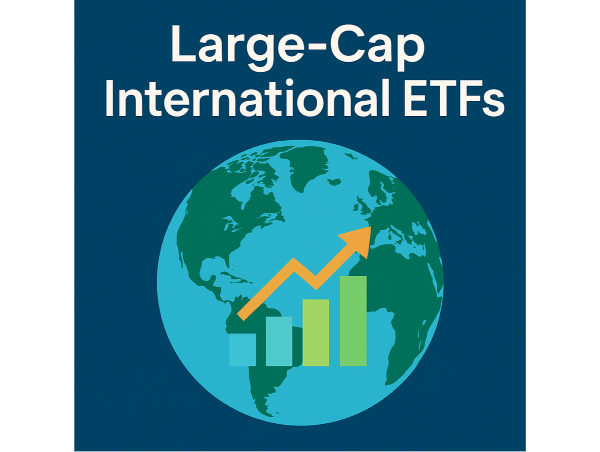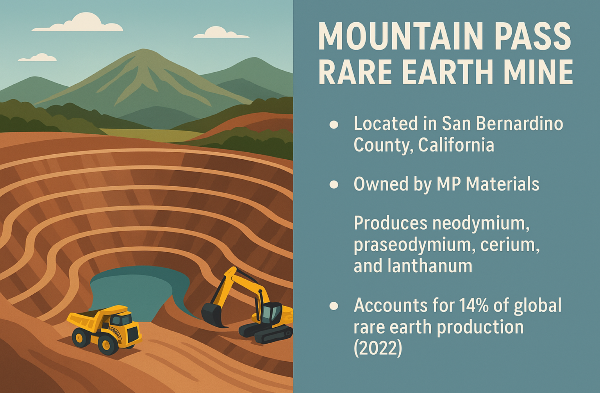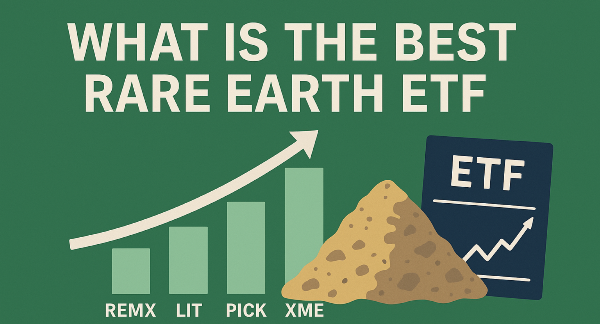Introduction
Large-cap international ETFs offer investors exposure to some of the world's largest and most established companies across various industries and regions. These funds provide diversification beyond domestic markets, allowing investors to tap into global economic growth while managing risk through a broad portfolio of large-cap stocks. Many investors seek international large-cap exposure to balance their portfolios, hedge against local market downturns, and capitalize on opportunities in emerging and developed economies.
Understanding Large-Cap International ETFs
Large-cap stocks are shares of well-established companies with significant market capitalization, typically exceeding billions of dollars. These companies often have strong financial stability, consistent revenue streams, and a dominant presence in their respective industries. Large-cap international ETFs provide investors with exposure to these global giants, offering a diversified portfolio that spans multiple countries and sectors. International large-cap ETFs differ from domestic ETFs in several key ways. While domestic ETFs focus on companies within a single country, international ETFs include firms from various global markets. This broader exposure helps investors mitigate risks associated with economic downturns in any one region. International ETFs may track different indices, such as the MSCI World Index or FTSE Global All Cap Index.
Key Advantages of Investing in Large-Cap International ETFs
Large-cap international ETFs provide investors with a stable foundation for portfolio growth. Compared to small-cap stocks, large-cap companies tend to exhibit lower volatility due to their established market presence and financial resilience. These ETFs offer exposure to firms with strong balance sheets, consistent revenue streams, and a history of weathering economic downturns. Another key advantage of large-cap international ETFs is access to industry-leading global companies. These funds include multinational corporations that dominate their respective sectors, from technology giants to consumer goods leaders.
Large-cap international ETFs also offer potential for long-term capital appreciation and dividend yield. Many of the companies included in these ETFs have a track record of increasing shareholder value through stock price growth and regular dividend payments.
Popular Large-Cap International ETFs
Large-cap international ETFs provide investors with exposure to well-established companies across global markets. These funds track indices that include multinational corporations from developed and emerging economies, offering diversification beyond domestic investments. Some of the most popular large-cap international ETFs include the Vanguard Total International Stock ETF (VXUS), iShares Core MSCI Total International Stock ETF (IXUS), and iShares MSCI EAFE Growth ETF (EFG). When comparing large-cap international ETFs, investors should consider key performance metrics, expense ratios, and sector allocations. VXUS provides broad exposure to international markets, including both developed and emerging economies, while IXUS focuses primarily on developed markets.
Expense ratios vary among funds, with Vanguard ETFs typically offering lower costs compared to actively managed alternatives. Additionally, sector allocations differ, with some ETFs emphasizing technology, financials, or consumer goods, depending on their underlying index. Additionally, liquidity and trading volume should be considered.
Factors to Consider When Selecting a Large-Cap International ETF
Expense ratios and fund costs play a crucial role in selecting a large-cap international ETF. Lower expense ratios help investors maximize returns by minimizing fees associated with fund management. While passive ETFs generally have lower costs, actively managed funds may justify higher fees with strategic stock selection and risk management. Sector and geographic diversification are key considerations when choosing a large-cap international ETF. Some funds focus on specific regions, such as Europe or Asia, while others provide broad exposure across developed and emerging markets. Sector allocations also vary. Dividend yield and total return expectations influence an ETF’s attractiveness for income-focused investors.
Risk Factors Associated with Large-Cap International ETFs
Currency risk is a significant factor when investing in large-cap international ETFs. Since these funds hold assets denominated in foreign currencies, fluctuations in exchange rates can impact returns. Some ETFs offer currency-hedged options to mitigate this risk, but they often come with higher expense ratios. Geopolitical and economic instability can also affect large-cap international ETFs. Political events, trade disputes, and economic downturns in specific regions can lead to market volatility. Market correlation and potential downturns pose another challenge for international ETF investors. While diversification helps mitigate risk, global markets are often interconnected. A downturn in one major economy can trigger declines in others, affecting large-cap stocks worldwide.
Tax Implications of Investing in International ETFs
Taxation on international ETFs differs from domestic investments due to varying regulations across countries. Investors holding foreign assets may be subject to both U.S. income tax and taxes imposed by the country where the ETF is domiciled. Some nations have no capital gains tax, while others levy taxes on dividends and interest earned from international holdings. To mitigate double taxation, the U.S. offers a foreign tax credit. Foreign withholding taxes can significantly impact returns on international ETFs. Many countries impose a withholding tax on dividends paid to foreign investors, reducing the net income received. Investors can minimize tax burdens by selecting funds domiciled in countries with favorable tax treaties or opting for ETFs that reinvest dividends rather than distributing them. Additionally, holding international ETFs in tax-advantaged accounts, such as IRAs, can help reduce taxable income.
Strategies for Building a Portfolio with Large-Cap International ETFs
Building a well-balanced portfolio with large-cap international ETFs requires strategic diversification. Investors often combine international ETFs with domestic funds to achieve a mix of global and local exposure. This approach helps mitigate risks associated with economic downturns in any single region while capitalizing on growth opportunities worldwide. A core-and-satellite strategy, where broad-market ETFs form the foundation and region-specific ETFs act as complementary holdings, can enhance portfolio stability. ETFs also provide a way to target specific regions or sectors based on market trends and economic outlooks.
Sector-based ETFs allow investors to concentrate on industries such as technology, healthcare, or financial services, depending on their investment objectives. Choosing between active and passive investment approaches is another key consideration. Passive ETFs track established indices, offering low-cost exposure to broad markets with minimal management intervention. Active ETFs, on the other hand, involve professional fund managers who make strategic decisions to outperform benchmarks.
Future Trends in Large-Cap International ETFs
Emerging markets are playing an increasingly significant role in large-cap investing. As economies in regions such as Asia and Latin America continue to expand, multinational corporations based in these areas are gaining prominence in global indices. Investors seeking exposure to high-growth markets often turn to ETFs that include large-cap stocks from emerging economies. Shifting economic dynamics are influencing the performance of large-cap international ETFs. Factors such as inflation rates, interest rate policies, and geopolitical events impact global markets, leading to fluctuations in ETF valuations. Technological advancements are reshaping international markets and large-cap investing.
Conclusion
Large-cap international ETFs offer investors a valuable opportunity to diversify their portfolios, gain exposure to industry-leading global companies, and navigate shifting economic dynamics. These funds provide stability, long-term growth potential, and access to emerging markets, making them an essential component of a well-balanced investment strategy. While factors such as currency risk, taxation, and sector allocation require careful consideration, the right ETF selection can enhance returns and mitigate global market volatility. As financial landscapes evolve and technological advancements reshape industries, large-cap international ETFs will continue to play a pivotal role in global investing. Investors who stay informed and strategically incorporate these funds can position themselves for sustained success in an increasingly interconnected economy.




























Introduction
Large-cap international ETFs offer investors exposure to some of the world's largest and most established companies across various industries and regions. These funds provide diversification beyond domestic markets, allowing investors to tap into global economic growth while managing risk through a broad portfolio of large-cap stocks. Many investors seek international large-cap exposure to balance their portfolios, hedge against local market downturns, and capitalize on opportunities in emerging and developed economies.
Understanding Large-Cap International ETFs
Large-cap stocks are shares of well-established companies with significant market capitalization, typically exceeding billions of dollars. These companies often have strong financial stability, consistent revenue streams, and a dominant presence in their respective industries. Large-cap international ETFs provide investors with exposure to these global giants, offering a diversified portfolio that spans multiple countries and sectors. International large-cap ETFs differ from domestic ETFs in several key ways. While domestic ETFs focus on companies within a single country, international ETFs include firms from various global markets. This broader exposure helps investors mitigate risks associated with economic downturns in any one region. International ETFs may track different indices, such as the MSCI World Index or FTSE Global All Cap Index.
Key Advantages of Investing in Large-Cap International ETFs
Large-cap international ETFs provide investors with a stable foundation for portfolio growth. Compared to small-cap stocks, large-cap companies tend to exhibit lower volatility due to their established market presence and financial resilience. These ETFs offer exposure to firms with strong balance sheets, consistent revenue streams, and a history of weathering economic downturns. Another key advantage of large-cap international ETFs is access to industry-leading global companies. These funds include multinational corporations that dominate their respective sectors, from technology giants to consumer goods leaders.
Large-cap international ETFs also offer potential for long-term capital appreciation and dividend yield. Many of the companies included in these ETFs have a track record of increasing shareholder value through stock price growth and regular dividend payments.
Popular Large-Cap International ETFs
Large-cap international ETFs provide investors with exposure to well-established companies across global markets. These funds track indices that include multinational corporations from developed and emerging economies, offering diversification beyond domestic investments. Some of the most popular large-cap international ETFs include the Vanguard Total International Stock ETF (VXUS), iShares Core MSCI Total International Stock ETF (IXUS), and iShares MSCI EAFE Growth ETF (EFG). When comparing large-cap international ETFs, investors should consider key performance metrics, expense ratios, and sector allocations. VXUS provides broad exposure to international markets, including both developed and emerging economies, while IXUS focuses primarily on developed markets.
Expense ratios vary among funds, with Vanguard ETFs typically offering lower costs compared to actively managed alternatives. Additionally, sector allocations differ, with some ETFs emphasizing technology, financials, or consumer goods, depending on their underlying index. Additionally, liquidity and trading volume should be considered.
Factors to Consider When Selecting a Large-Cap International ETF
Expense ratios and fund costs play a crucial role in selecting a large-cap international ETF. Lower expense ratios help investors maximize returns by minimizing fees associated with fund management. While passive ETFs generally have lower costs, actively managed funds may justify higher fees with strategic stock selection and risk management. Sector and geographic diversification are key considerations when choosing a large-cap international ETF. Some funds focus on specific regions, such as Europe or Asia, while others provide broad exposure across developed and emerging markets. Sector allocations also vary. Dividend yield and total return expectations influence an ETF’s attractiveness for income-focused investors.
Risk Factors Associated with Large-Cap International ETFs
Currency risk is a significant factor when investing in large-cap international ETFs. Since these funds hold assets denominated in foreign currencies, fluctuations in exchange rates can impact returns. Some ETFs offer currency-hedged options to mitigate this risk, but they often come with higher expense ratios. Geopolitical and economic instability can also affect large-cap international ETFs. Political events, trade disputes, and economic downturns in specific regions can lead to market volatility. Market correlation and potential downturns pose another challenge for international ETF investors. While diversification helps mitigate risk, global markets are often interconnected. A downturn in one major economy can trigger declines in others, affecting large-cap stocks worldwide.
Tax Implications of Investing in International ETFs
Taxation on international ETFs differs from domestic investments due to varying regulations across countries. Investors holding foreign assets may be subject to both U.S. income tax and taxes imposed by the country where the ETF is domiciled. Some nations have no capital gains tax, while others levy taxes on dividends and interest earned from international holdings. To mitigate double taxation, the U.S. offers a foreign tax credit. Foreign withholding taxes can significantly impact returns on international ETFs. Many countries impose a withholding tax on dividends paid to foreign investors, reducing the net income received. Investors can minimize tax burdens by selecting funds domiciled in countries with favorable tax treaties or opting for ETFs that reinvest dividends rather than distributing them. Additionally, holding international ETFs in tax-advantaged accounts, such as IRAs, can help reduce taxable income.
Strategies for Building a Portfolio with Large-Cap International ETFs
Building a well-balanced portfolio with large-cap international ETFs requires strategic diversification. Investors often combine international ETFs with domestic funds to achieve a mix of global and local exposure. This approach helps mitigate risks associated with economic downturns in any single region while capitalizing on growth opportunities worldwide. A core-and-satellite strategy, where broad-market ETFs form the foundation and region-specific ETFs act as complementary holdings, can enhance portfolio stability. ETFs also provide a way to target specific regions or sectors based on market trends and economic outlooks.
Sector-based ETFs allow investors to concentrate on industries such as technology, healthcare, or financial services, depending on their investment objectives. Choosing between active and passive investment approaches is another key consideration. Passive ETFs track established indices, offering low-cost exposure to broad markets with minimal management intervention. Active ETFs, on the other hand, involve professional fund managers who make strategic decisions to outperform benchmarks.
Future Trends in Large-Cap International ETFs
Emerging markets are playing an increasingly significant role in large-cap investing. As economies in regions such as Asia and Latin America continue to expand, multinational corporations based in these areas are gaining prominence in global indices. Investors seeking exposure to high-growth markets often turn to ETFs that include large-cap stocks from emerging economies. Shifting economic dynamics are influencing the performance of large-cap international ETFs. Factors such as inflation rates, interest rate policies, and geopolitical events impact global markets, leading to fluctuations in ETF valuations. Technological advancements are reshaping international markets and large-cap investing.
Conclusion
Large-cap international ETFs offer investors a valuable opportunity to diversify their portfolios, gain exposure to industry-leading global companies, and navigate shifting economic dynamics. These funds provide stability, long-term growth potential, and access to emerging markets, making them an essential component of a well-balanced investment strategy. While factors such as currency risk, taxation, and sector allocation require careful consideration, the right ETF selection can enhance returns and mitigate global market volatility. As financial landscapes evolve and technological advancements reshape industries, large-cap international ETFs will continue to play a pivotal role in global investing. Investors who stay informed and strategically incorporate these funds can position themselves for sustained success in an increasingly interconnected economy.